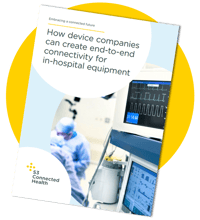The number of connected medical devices and device-based services on the market is increasing rapidly. To realize their full potential, the data they collect must be organized, processed, and turned into real insights that can be actioned by the end-user.
The problem is that not every individual device vendor or healthcare company has the staff, skills, or technology needed to do this, making new connected health projects a challenge.
A data integration project is essential for bridging the gap, ensuring all your teams are on the same page, your devices can communicate effectively with one another, and your business can derive the maximum value from the data you gather in the long run.
I’ve put together the following top-tips for data integration projects, based on my experience across numerous projects:
A top-down data strategy makes data accessible to all business functions
Every department – from R&D, to finance, manufacturing, sales, and engineering – will benefit differently from data gathered on devices.
The problem is, approaching data just at the department level results in a very fragmented view. Without clear sight of all the data a device produces, it’s much harder to get teams the right data they need, in the right format. That can lead to confusion or, worse still, mistakes further downstream.
A holistic view of all data also allows manufacturers to gain a better understanding of their supply chains, identify maintenance needs, or even offer further training if a device is not performing at its full potential.
Up-front analysis and planning smoothes interfacing across multiple systems
Interfacing with multiple systems efficiently can be complex and require significant time and resources.
To avoid delays and confusion, interactions and interfaces should be planned out up-front as much as possible. A data integration program will ensure that devices are connected seamlessly, and data is shared and presented in an easily comprehensible and manageable way. That, in turn, means data can be easily funneled into other more advanced applications for further processing.
This process should become even easier in the future as JSON API interfaces become more ubiquitous; new regulations are also driving the adoption of standards such as HL7 FHIR, which mandates for broader interoperability.
Engaging stakeholders early prevents mismatched priorities between teams
Any new project is likely to face resistance of some sort, especially if it aims to disrupt existing business priorities and processes.
Minimizing that resistance and ensuring digital health projects run efficiently requires in-depth planning and comprehensive buy-in from all teams involved in the plan, as well as high-level stakeholders.
A data integration project is particularly helpful here. By offering a clear outline of a program, including the relevant workflows, technology, team, and data requirements, everyone involved in a project knows exactly what is happening and how a given device will work. That prevents miscommunication and misunderstanding in the short term, and mismatched internal priorities further down the road.
Delivering to external customers requires different IT skills
IT teams often focus internally on providing services directly to employees. But since many digital projects have a direct customer interface, a different IT approach must be adopted.
Getting team members with the required skill sets for the job may require redeploying resources within an organization, or even hiring an IT project manager to ensure the necessary requirements are understood and implemented correctly.
A data integration project is useful in this scenario, too. By laying out a clear overview of a project in its entirety, businesses can more easily assess the capabilities they already have internally, and any gaps they mean to fill externally, ensuring projects roll out smoothly with the fewest possible delays.
Data integration unlocks the full value of connected devices
The medical device industry is advancing rapidly, and it’s tempting to dive straight into any digital transformation project and just start building. But inadequate preparation can make a project far lengthier and more costly than intended.
With so much complexity involved in a successful connected device or device-based service, investing in a data integration project means you can rest assured that your data is accessible, your devices communicate correctly, and your reporting is available whenever and in whichever form it’s needed.
By Derek Dwyer,
Director of Strategic Programs,
S3 Connected Health
A data integration project is just one of the many steps in successfully creating an end-to-end solution around a connected device.
To find out more about the rest of the process, read our whitepaper:
How medical device companies can create end-to-end connectivity for in-hospital equipment



